The Dao people in Ha Giang are deeply connected to the mountains they call home. Known for their spiritual beliefs, symbolic clothing, and rich oral traditions, they remain one of Vietnam’s most culturally distinctive ethnic groups. With Phieu Travel, you’ll gain firsthand insight into this heritage – through guided visits, traditional festivals and immersive experiences that bring Dao customs and community life into vivid focus.
1. The Dao People – A mysterious ethnic culture in Ha Giang
Historically, the Dao migrated from southern China in waves spanning from the 12th to the 20th century. These movements were driven by social and political pressures, leading them to settle in the highlands of northern Vietnam. Over time, they developed strong cultural ties to their new environment, particularly in remote areas like Ha Giang where traditions remain deeply rooted.
Today, the Dao people are one of the largest ethnic minorities in Ha Giang, making up over 14% of the province’s population. They are concentrated in mountainous districts such as Hoang Su Phi, Quan Ba, Vi Xuyen, and Bac Me. Many Dao villages are nestled on steep hillsides, where farming, handicrafts and clan-based rituals continue to shape daily life.
The Dao people in Ha Giang include several prominent subgroups like Dao Ao Dai, Dao Quan Trang, Dao Dai Ban, Dao Tieu Ban and more. Across different regions, they are also known by names such as Kiem Mien, Kim Mon, Du Mien,…. Despite regional differences, most Dao communities share a strong emphasis on ancestral worship, tight-knit family systems, rich oral traditions that bind generations together.
The Ultimate Ha Giang Loop Guide (2025): Itinerary, Map & Tips
2. Distinctive characteristics of the Dao ethnic group
The sections below offer a closer look at the daily life and deep-rooted customs that define Dao identity in Ha Giang.
2.1 How the Dao people make a living
Agriculture is central to the Dao economy and is adapted to the mountainous landscape. They grow rice, maize, beans, pumpkins, and root vegetables through wet-rice farming, swidden methods, and rock-hole planting. Groups like the Dao Ao Dai and Dao Quan Trang favor terraced paddies, while the Red Dao specialize in cultivating rocky slopes.
Animal husbandry complements farming and supports both subsistence and ceremony. Buffaloes, pigs, chickens, and cattle are raised in mid-altitude areas, while goats and horses are kept higher up. Livestock is essential for transport, dowries, rituals, and daily meals – deeply woven into Dao social life.
Craftsmanship sustains cultural identity. Dao families weave, dye and sew ceremonial clothing, while artisans produce paper for rituals and tools for daily use. These skills are passed down through generations, preserving heritage through hands and habit.
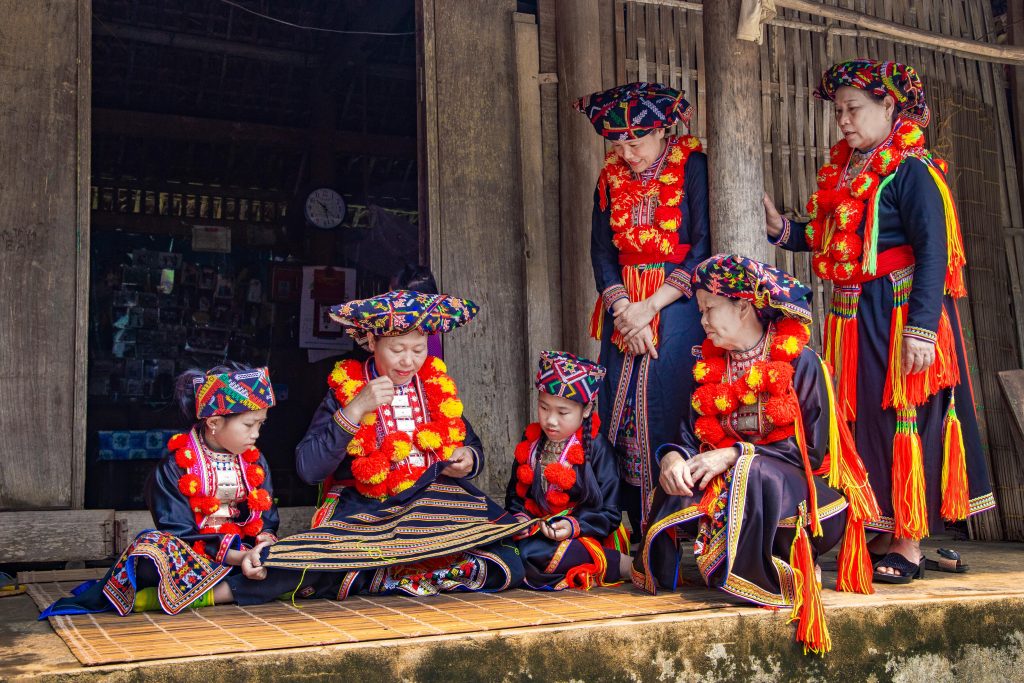
2.2 Language of the Dao people
The Dao speak languages from the Hmong – Mien family, with each subgroup using unique dialects. For example, the Red Dao preserves an oral tradition closely related to H’mong. Despite linguistic variety, storytelling and ritual chanting remain central to cultural life.
Dao writing systems are adapted from classical Chinese characters, modified for pronunciation. These scripts appear in religious texts, incantations, and clan records, typically maintained by shamans or spiritual elders. While rarely used in daily speech, they hold profound cultural weight.
Many Dao individuals are multilingual, speaking Vietnamese, H’mong or Chinese depending on their location. This adaptability enables cultural preservation while facilitating trade, education, and regional integration.
2.3 Traditional housing of the Dao people
Dao houses follow three styles: ground-level dwellings, stilt houses, and half-stilt hybrids, depending on terrain and regional customs. Most homes are built with timber frames resting on stone foundations to resist termites and moisture.
Roof design is crucial to durability. The Red Dao often use yin-yang tiles, prized for their airflow and rain resistance. In calmer areas, rooftops need no stone weights, helping maintain structural harmony without excess materials.
Inside, living spaces follow a practical yet symbolic layout. The central area is dedicated to ancestor worship. Side rooms serve for sleeping, cooking or storage. Some houses include upper lofts for storing food or tools. This arrangement reflects the Dao’s respect for harmony between daily life and spiritual values – sustained through generations.
2.4 Traditional attire of the Dao people
Dao brocade clothes are rich in symbolism and vary by subgroup. Women wear dresses, skirts, or trousers with embroidered jackets, while men traditionally tied their long hair in topknots and wore short jackets with long pants. A square cloth on the back signifies ancestral ties.
The Red Dao are especially noted for their visually striking attire. Women wear long tunics over trousers, with embroidery on both sides of the fabric. Many shave their eyebrows and parts of their scalp, leaving a central topknot. A red triangular scarf, adorned with silver coins and tassels, completes the look. These details express religious belief and strengthen group identity.
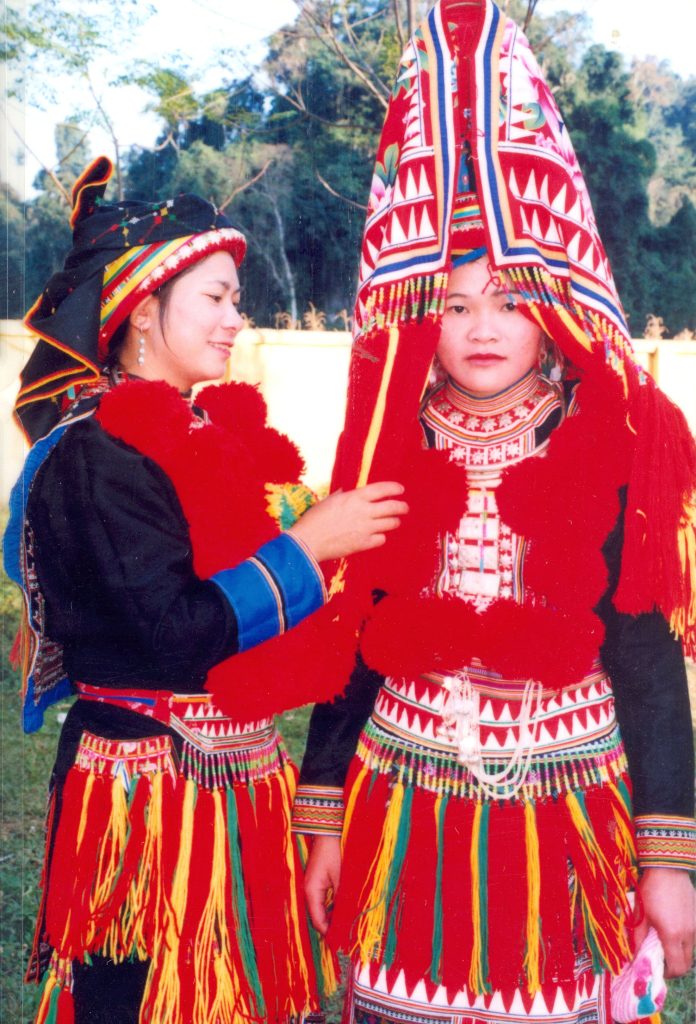
2.5 Social organization of the Dao community
Dao society is patrilineal, with men leading family, farming and religious ceremonies. In Red Dao villages, men direct weddings, funerals, house-building events – playing key roles in both communal and spiritual realms.
Families belong to distinct clans, often with surnames like Ban, Trieu, or Ly. A shared middle name is assigned by generation, reinforcing lineage and collective memory within the community.
2.6 Artistic and cultural expressions of the Dao people
Music and storytelling are central to Dao cultural life. Solo and call-and-response singing are performed during festivals, housewarming rituals and village gatherings. Communities maintain traditional instruments such as drums, cymbals, bells, buffalo horns, flutes, mouth harps.
Folktales play an essential role in transmitting history and values. Stories like The Singing Fox and The Legend of Rice are passed down by elders to younger generations, helping preserve collective identity. During major celebrations, villagers also take part in folk games and performing arts such as bamboo swing contests, spinning tops, symbolic dances that blend play with ritual meaning.
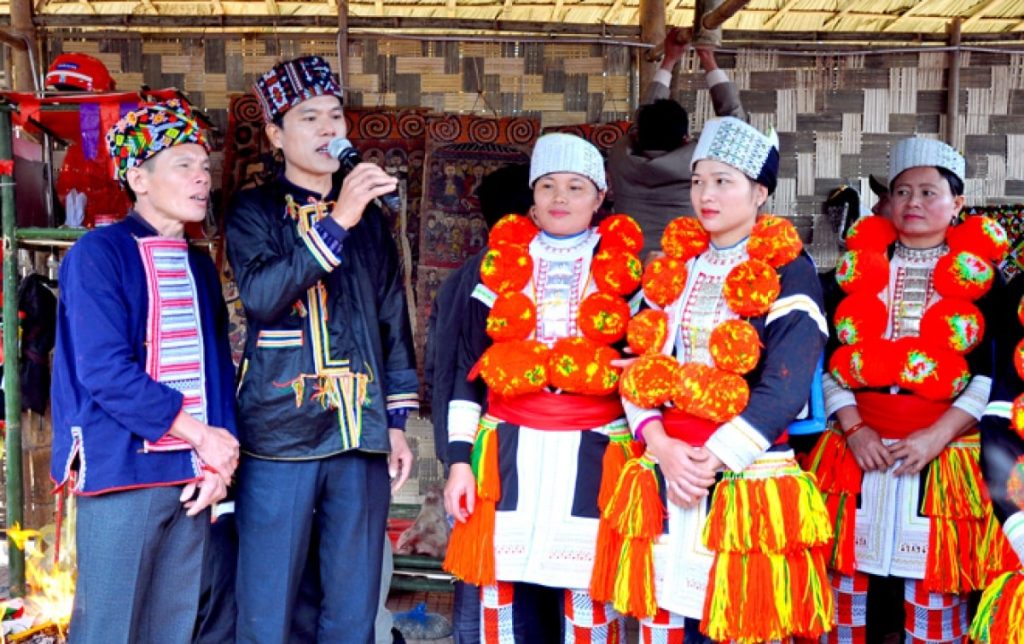
Ha Giang in August: Weather, Things to Do & Travel Tips
2.7 Traditional customs and spiritual beliefs
The Dao people preserve a rich spiritual world rooted in ancestor worship, symbolic rituals, and generational traditions. Ceremonies mark life events like building a house, giving birth, getting married or holding funerals.
2.7.1 Religion and belief system of the Dao people
The Dao practice animistic polytheism shaped by Taoism, with additional influences from Confucianism and Buddhism. At the core is ancestor worship, known as Ban Ho, along with reverence for Ban Vuong – the mythical founder of the Dao people. Altars are placed in sacred household spaces, where offerings are made on key lunar days.
Beyond ancestors, Dao communities worship natural spirits tied to agriculture and everyday life. These include deities of wind, rain, rice, livestock and water. Seasonal rites, especially the new rice ritual, express a deep connection between spiritual belief and subsistence farming.
2.7.2 Spiritual rituals for choosing house sites
In Red Dao tradition, selecting a home site involves both physical and spiritual signs. At night, the family digs a small hole, fills it with rice to represent people, livestock, and wealth, then covers it. By morning, if the rice remains, the land is considered favorable. If it disappears, they believe the site lacks spiritual support and must search again. This practice reflects the Dao’s belief that ancestors and nature spirits influence major decisions.
2.7.3 Childbirth customs of the Dao people
Among the Red Dao, childbirth typically takes place inside the mother’s bedroom with support from female relatives like her mother or sisters. After delivery, the newborn is bathed in warm water. To protect the child from harmful spirits, families place green branches or banana flowers at the door. On the third day, a ritual is held to honor the mother, recognizing her role in bringing new life into the household.
2.7.4 Wedding traditions
In Dao communities, marriage is traditionally arranged by the groom’s family. Fathers begin searching for a bride when their sons reach 14 or 15 years old, prioritizing health, work ethic and family contribution. A Dao shaman then evaluates the couple’s compatibility through foot impressions and astrological charts.
The bride price – typically silver, livestock and rice wine – is delivered to the bride’s household. On the wedding day, the groom carries the bride on his back across the threshold, where she steps over a pair of scissors, symbolizing the cutting of past ties. In households without sons, the family may welcome a groom into the bride’s home, though this is often viewed as socially inferior if due to financial hardship.
2.7.5 Funeral customs
In Dao tradition, funerals are essential for ensuring spiritual peace. When a family member dies, a ritual master known as “thầy tào” is invited to conduct ceremonies and select a proper burial site. The deceased is wrapped in cloth and placed in a wooden coffin, which remains in the home until burial in a stone-marked grave. In the past, those over twelve were sometimes cremated.
The funeral spans three days. The first day releases the soul, the second involves home-based offerings, and the third completes the rite of passage. These practices reflect a deep belief in the afterlife and the importance of guiding spirits with dignity and care.
Five-Colored Sticky Rice: An Exquisite Art of Highland Cuisine
3. Traditional festivals of the Dao People in Ha Giang
Dao communities in Ha Giang hold vibrant festivals that reflect both spiritual beliefs and seasonal rhythms. The following events highlight key traditions still practiced today. With the right timing, Phieu Travel can help you attend these festivals as part of a guided Ha Giang Loop tour – offering front-row access to Dao spiritual and communal life.
3.1 Ban Vuong Festival
The Ban Vuong Festival, held from the 15th of the Tenth Lunar Month to the end of the Twelfth, honors ancestors and Ban Vuong, the legendary founder of the Dao people. It is a time to express gratitude, pray for good harvests and weather and teach cultural values to younger generations. After the main rituals, communities gather for festive games like fire jumping, pestle wrestling, and the symbolic “Catching Turtles” dance.
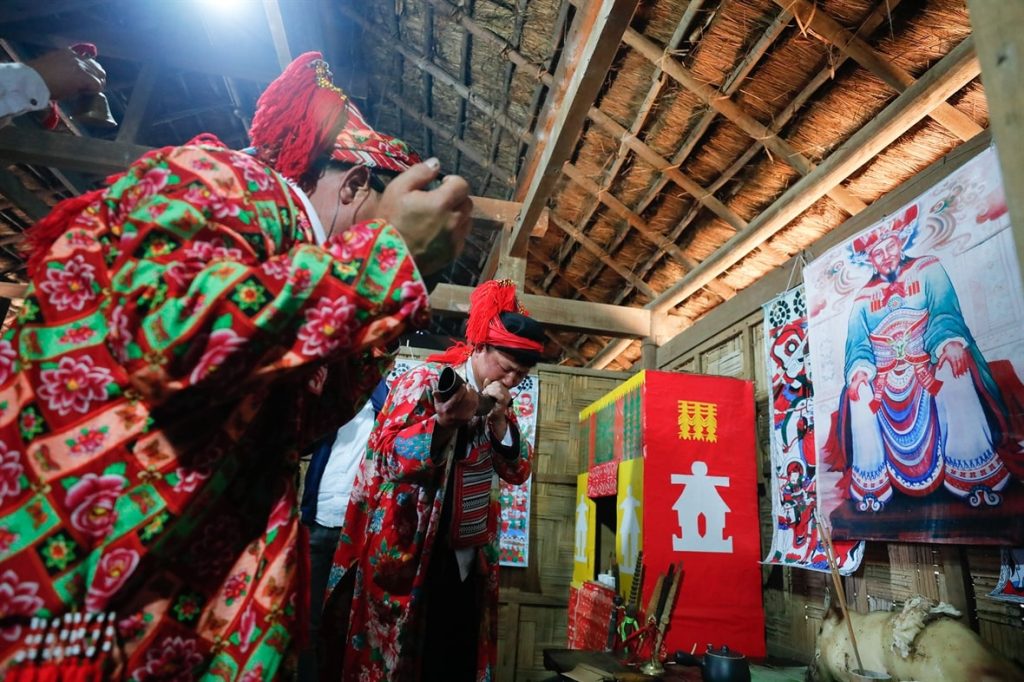
3.2 Harvest Prayer Festival
The Harvest Prayer Festival, celebrated by Red Dao communities between the Tenth Lunar Month and the Second Lunar Month of the new year, is a major spiritual event. Each clan sends a representative to offer prayers for peace, health and a prosperous harvest. Offerings include pigs, roosters, sticky rice, banh chung,.., all carefully prepared.
Ritual masters conduct ceremonies to honor deities of the sky, land, forest, and water. After the rites, villagers join in Pi Lè horn music, bell dancing, and drumming to dispel bad luck. Traditional games such as tug of war and con throwing follow—turning the ritual into a joyful, community-wide celebration.
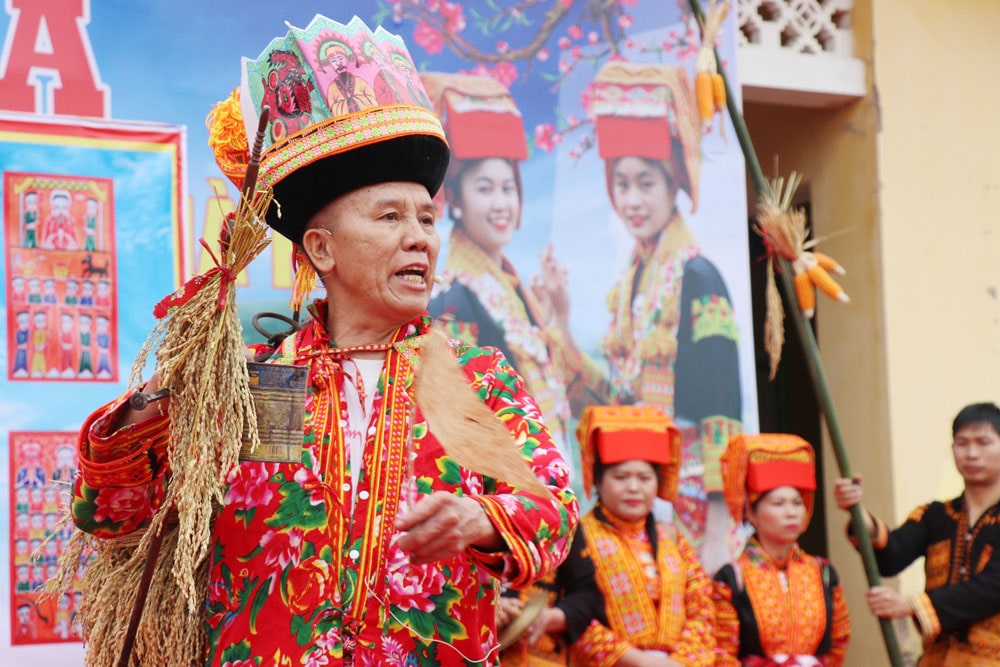
3.5 Cap Sac (Coming-of-Age) Festival
The Cap Sac is a vital rite of passage for Dao men, symbolizing spiritual maturity and granting ritual authority. It’s usually performed during the farming off-season for boys aged 10 and older. During the ceremony, the initiate receives a sacred name and is formally recognized as a descendant of Ban Vuong.
The ritual varies by subgroup and may involve 3, 7, or 12 sacred lamps, each marking a different spiritual level. Dao shamans lead the ceremony with chants, symbolic dances, paper talismans and offerings. After completion, the initiate is permitted to conduct ancestral worship and take on religious roles within the community.
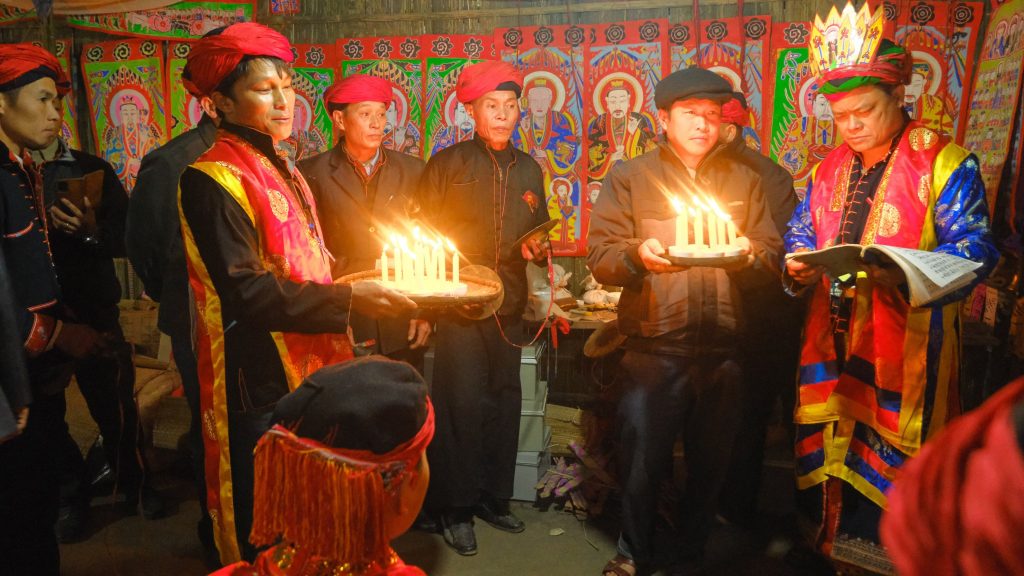
3.6 Traditional Lunar New Year (Tet Co Truyen)
The Dao’s Traditional Lunar New Year is celebrated at the same time as Vietnam’s Lunar New Year. Villagers gather at the elder’s home to prepare for “Tet Nhay” – a vibrant dance festival. Throughout the celebration, people take turns dancing day and night in a rotating rhythm of music, poetry, and movement. This unique tradition blends Dao folk arts and reinforces community bonds during the new year.
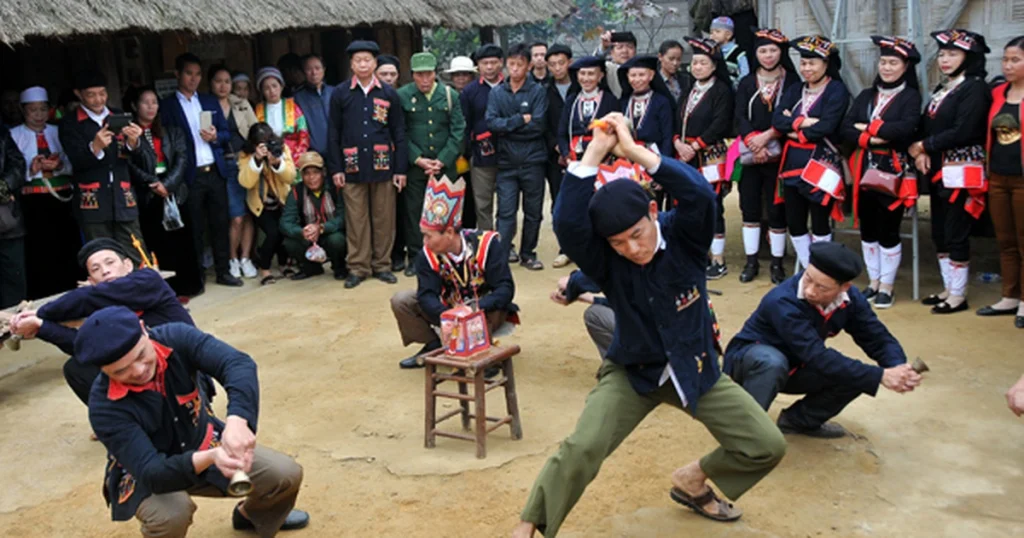
4. Tips for experiencing Dao cultural tourism
To truly connect with the Dao people’s culture in Ha Giang, consider immersive activities rooted in daily life and tradition:
4.1 Visit the Nam Dam cultural village
Nam Dam, located in Quan Ba District about 45 km (28 miles) from Ha Giang City, is a Dao Cham village where 100% of residents belong to the same ethnic group. The village features traditional earth-walled homes with yin-yang roofs, seasonal festivals, and hands-on workshops in herbal medicine and fabric dyeing.
4.2 Try local dishes
Dao cuisine highlights seasonal produce and mountain staples. Typical dishes include bamboo-tube rice, herbal chicken broth, Thang Co (a traditional stew), and corn liquor. Meals are cooked over wood fires and served communally, turning food into a shared cultural experience.
4.3 Experience herbal leaf bathing
Herbal leaf bathing is a signature Dao healing practice using a mix of forest plants known for medicinal properties. Baths are prepared in large wooden tubs, often within family homes or local homestays. The steam relaxes muscles and is believed to treat fatigue, flu or joint pain.
4.4 Join Dao traditional festivals
Plan your visit during the Ban Vuong Festival or Cap Sac ceremonies for a powerful cultural experience. Music, fire rituals and symbolic dances showcase the Dao’s spiritual depth and community values.
The Dao People preserve a vibrant culture rooted in tradition and mountain life. Phieutravel.com offers curated tours that let you fully experience their heritage – through festivals, rituals and everyday moments across Ha Giang. Contact us now!
Read more:
- H’mong People in Ha Giang: Traditions, Life & Travel Tips
- Inside the Life of the Lo Lo People in Vietnam
- Exploring Highland Cuisine: 20 Must-Try Dishes in Ha Giang
- Is There a Ha Giang Airport and How to Reach Ha Giang by Air Travel
- Ha Giang Loop vs Sapa? The Ultimate Guide for Solo Adventurers in Northern Vietnam
- La Chi People Vietnam – History, Culture, Traditions & Villages in Ha Giang

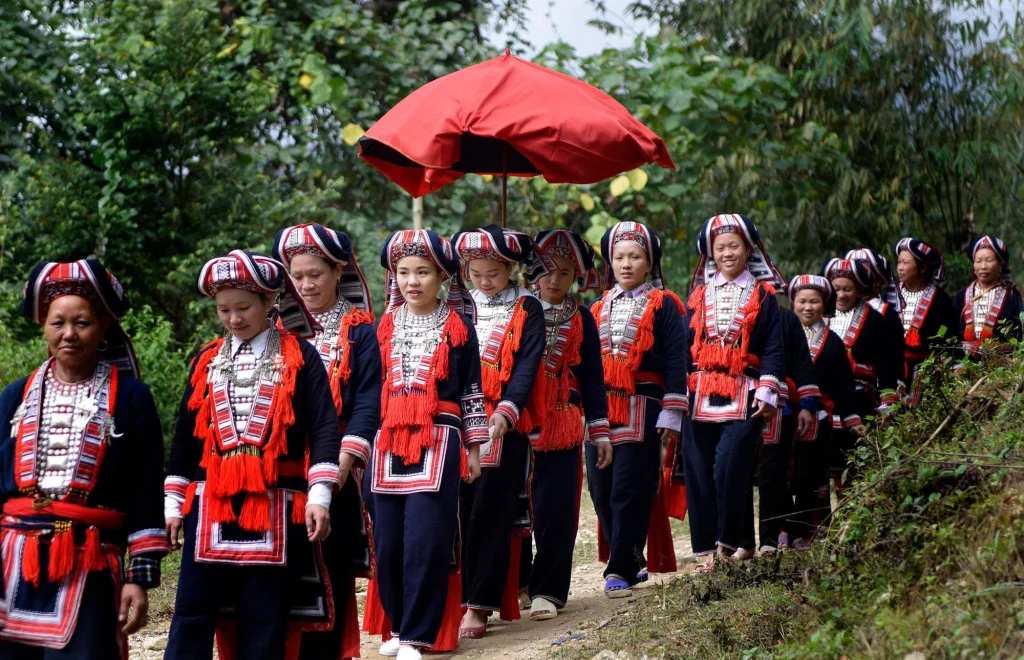
You Might Also Like
Ha Giang Weather in September: Complete Guide for Travelers
Exploring the magnificent Ha Giang Loop in September offers travelers a perfect balance of favorable[...]
Quan Ba Twin Mountains: Ha Giang’s Iconic Fairy Hills and Complete Travel Guide
The mystical Quan Ba Twin Mountains rise from the emerald valleys of Ha Giang like[...]
Vuong family mansion: the architectural marvel and cultural legacy of Ha Giang
Deep in Vietnam’s northern highlands, where mist-shrouded mountains meet terraced rice fields, stands a testament[...]
Ha Giang Loop Safety Tips: How to Ride Securely in Vietnam’s Northern Mountains
The Ha Giang Loop, with its winding mountain roads and breathtaking landscapes, offers one of[...]
The Ultimate Guide to the M-Shaped Curve on Ha Giang Loop
Vietnam’s remote northern province of Ha Giang hides a natural wonder that has captivated adventurous[...]
Most Beautiful Places to Visit in Vietnam: Essential Destinations and Insider Tips
Vietnam captivates travelers with its stunning landscapes, rich cultural heritage, and warm hospitality. From mist-shrouded[...]
Beyond the Beaten Path: Discovering Ha Giang Province in Northeast Vietnam
Ha Giang Province in Northeast Vietnam stands as one of the country’s last frontiers for[...]
Rainy season in Ha Giang: what to expect, when to go, and travel tips
Vietnam’s northern frontier reveals a different face during the rainy season, transforming Ha Giang’s limestone[...]